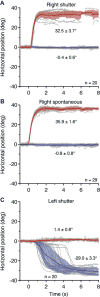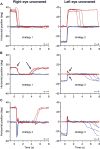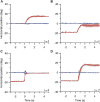Capturing the Moment of Fusion Loss in Intermittent Exotropia
- PMID: 28081943
- PMCID: PMC5685669
- DOI: 10.1016/j.ophtha.2016.11.039
Capturing the Moment of Fusion Loss in Intermittent Exotropia
Abstract
Purpose: To characterize eye movements made by patients with intermittent exotropia when fusion loss occurs spontaneously and to compare them with those induced by covering 1 eye and with strategies used to recover fusion.
Design: Prospective study of a patient cohort referred to our laboratory.
Participants: Thirteen patients with typical findings of intermittent exotropia who experienced frequent spontaneous loss of fusion.
Methods: The position of each eye was recorded with a video eye tracker under infrared illumination while fixating on a small central near target.
Main outcome measures: Eye position and peak velocity measured during spontaneous loss of fusion, shutter-induced loss of fusion, and recovery of fusion.
Results: In 10 of 13 subjects, the eye movement made after spontaneous loss of fusion was indistinguishable from that induced by covering 1 eye. It reached 90% of full amplitude in a mean of 1.75 seconds. Peak velocity of the deviating eye's movement was highly correlated for spontaneous and shutter-induced events. Peak velocity was also proportional to exotropia amplitude. Recovery of fusion was more rapid than loss of fusion, and often was accompanied by interjection of a disconjugate saccade.
Conclusions: Loss of fusion in intermittent exotropia is not influenced by visual feedback. Excessive divergence tone may be responsible, but breakdown of alignment occurs via a unique, pathological type of eye movement that differs from a normal, physiological divergence eye movement.
Copyright © 2017 American Academy of Ophthalmology. Published by Elsevier Inc. All rights reserved.
Figures






Comment in
-
Reply.Ophthalmology. 2018 Feb;125(2):e13. doi: 10.1016/j.ophtha.2017.08.043. Ophthalmology. 2018. PMID: 29389410 No abstract available.
-
Re: Economides et al.: Capturing the moment of fusion loss in intermittent exotropia (Ophthalmology. 2017;124;496-504).Ophthalmology. 2018 Feb;125(2):e13. doi: 10.1016/j.ophtha.2017.08.042. Ophthalmology. 2018. PMID: 29389411 No abstract available.
References
-
- Kushner BJ, Morton GV. Distance/near differences in intermittent exotropia. Arch Ophthalmol. 1998;116(4):478–486. - PubMed
-
- Buck D, Powell C, Cumberland P, et al. Presenting features and early management of childhood intermittent exotropia in the UK: inception cohort study. Br J Ophthalmol. 2009;93(12):1620–1624. - PubMed
-
- Nusz KJ, Mohney BG, Diehl NN. The course of intermittent exotropia in a population-based cohort. Ophthalmology. 2006;113(7):1154–1158. - PubMed
Publication types
MeSH terms
Grants and funding
LinkOut - more resources
Full Text Sources
Other Literature Sources

